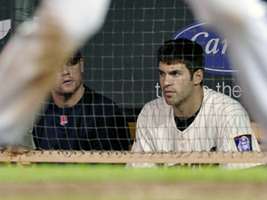
A comment in the earlier post about Joe Mauer moved me to pull out a spreadsheet I haven’t touched since 2003 today. It’s a spreadsheet I created consisting of calculations from baseball statistics guru Bill James, which he used to predict the future performance of players.
BROCK2, as he called it, considered the performance of a player, the age at which he turned in the performance, and how the performance compared to other players at the same position, among other things.
I found it to be a very accurate gauge although I think the last time I used it, it predicted Manny Ramirez would end his career with over 700 homers. BROCK2 doesn’t properly take drug use and goofiness into consideration.
The way the spreadsheet works is as you enter historical statistics for a player, it spits out a prediction for subsequent seasons.
After entering Mauer’s first three seasons, the spreadsheet predicted his performance this year would consist of a .347 batting average , 18 HR and 88 RBI while playing 155 games. Not too shabby.
The more data the spreadsheet has to work with, the more refined the predictions get. After entering his fourth season’s data — 2007 — the numbers didn’t change much in predicting this year, lowering his HR total only slightly. After entering 2008’s stats — a year in which he played 146 games — the production prediction continued to drop, though not precipitously.
2009’s statistics, once entered, doubled nearly all of the projections for the future. That was Mauer’s big season, of course. The spreadsheet said Mauer would hit 27 HR and bat .327 this year. It also predicted that the season Mauer would have in 2010, would be pretty much the season he had, except that it expected about 5-10 more HR.
And after entering last year’s statistics, going into this year, it said Mauer would bat .333 and hit 27 homers, and that his career would end with about 238 homers, although he’d play into his 40s.
What does the addition of this year’s statistics do? Since the season isn’t over, I pro-rated his performance so far over a full season, adding 18 percent (the amount of the season left) to his line.

That’s not horrible. But it’s not superstar, either. Curiously, if Mauer moved to first and his production remained roughly the same, his career would end sooner. More offense is expected from a firstbaseman.
If you’re a baseball stats freak who’d like to play with the spreadsheet — for a long time, as far I know, this was the only spreadsheet available using James’ formula — drop me an e-mail and I’ll send you a copy.
For all I know, this formula has been proven folly by now. I’m not as stat-freaky as I was in my hang-on-every-pitch youth. But here’s a write-up analyzing James’ method of evaluation.
One more note: The last time I used this on a Minnesota Twin was at the height of Lew Ford-mania. It predicted Lew’s career was about over. It was.
